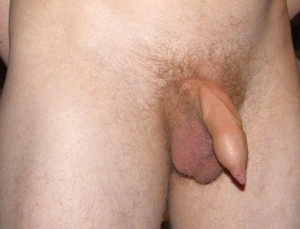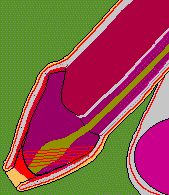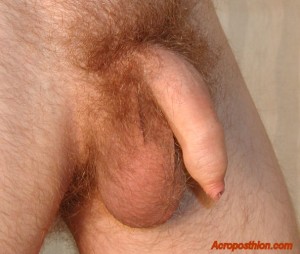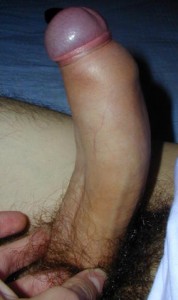Anatomy & Function
ANATOMY
 The foreskin, also called the prepuce [Latin: prae = in front & putium = penis] is the sheath of penile skin, which covers the head of the penis, known as the glans [Greek: balanos = acorn & Latin: (pl) glandes (pen[i]um) = acorn (of the penis)]. The skin of the penis is continuous, forming a cylindrical double layer of tissue consisting of the outer foreskin tapering at the acroposthion, which inverts into itself becoming the inner foreskin. Upon erection the foreskin may unroll itself, retracting into a single layered cylinder but it may also remain covering the glans and can be retracted manually. The variation and variety of what foreskins look like covers a broad spectrum. This range includes foreskins which are very long called a mega prepuce with ‘macroposthia’ being its official term, to those which are very short and there’s a rare condition called ‘aposthia’ whereby the foreskin is absent at birth. There’s also a broad variation in the foreskin’s capacity and ability to retract. Some foreskins retract with ease whilst others retract with difficulty, while others retract partially and some foreskins don’t retract at all.
The foreskin, also called the prepuce [Latin: prae = in front & putium = penis] is the sheath of penile skin, which covers the head of the penis, known as the glans [Greek: balanos = acorn & Latin: (pl) glandes (pen[i]um) = acorn (of the penis)]. The skin of the penis is continuous, forming a cylindrical double layer of tissue consisting of the outer foreskin tapering at the acroposthion, which inverts into itself becoming the inner foreskin. Upon erection the foreskin may unroll itself, retracting into a single layered cylinder but it may also remain covering the glans and can be retracted manually. The variation and variety of what foreskins look like covers a broad spectrum. This range includes foreskins which are very long called a mega prepuce with ‘macroposthia’ being its official term, to those which are very short and there’s a rare condition called ‘aposthia’ whereby the foreskin is absent at birth. There’s also a broad variation in the foreskin’s capacity and ability to retract. Some foreskins retract with ease whilst others retract with difficulty, while others retract partially and some foreskins don’t retract at all.
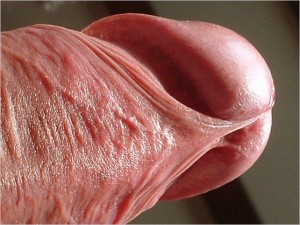
The preputial space and the frenulum which is the tethering structure attaching the glans and the shaft of the penis
The space between the foreskin and the glans is called the preputial space whilst the preputial sphincter of the foreskin, which is the “drawstring” of the acroposthion (the overhang tip of the foreskin), is formed of the temperature sensitive smooth muscle sheath called the dartos muscle. The frenulum [Latin: fraenum = bridle] is the membrane which attaches the foreskin to the glans and the shaft of the penis and is a highly erogenous tethering structure on the underside of the glans. The foreskin has more blood cells and nerve endings than almost any other skin on the body which makes it one of the most erotogenic zones of the male body.
The foreskin is laden with nerve endings called Meissner’s corpuscles, which are also found in the frenar band (the Ridged Band) a delicate belt or zone of densely innervated soft ridged, corrugated tissue or ridged bands running from the frenulum around the inside of the foreskin. The foreskin is copiously laden with coiled, fine touch mechanoreceptor nerve endings (Meissner’s corpuscles) concentrated in the peaks of the ridges, making them the most important sensory component of the foreskin. Specialized erotogenic nerve endings of several types are encapsulated there including the Vater-Pacinian cells, Merkel’s cells, Krause end-bulbs, nociceptors, and branches of the dorsal nerve and perineal nerve. These receptors can feel slight motion and stretch, subtle changes in temperature, and fine gradations in texture that are responsible for the perception of fine variations of touch and pleasure.
The inner foreskin contains apocrine glands, which secrete cathepsin B, lysozyme, chymotrypsin, neutrophil elastase, cytokine (a non-antibody protein that generates an immune response on contact with specific antigens), and pheromones such as androsterone. Lysozyme, which is also found in tears, human milk, and other body fluids, destroys bacterial cell walls. The average adult foreskin consists of 1½ inches of outer skin, 1½ inches of inner mucosal lining – totalling a length of 3 inches – and is 5 inches in circumference when erect. This amounts to a surface area of 15 square inches (100 square centimetres), or a surface area equivalent to that of a 3″ by 5″ inch index card. Thus circumcision removes around 15 square inches of specialised, erogenous and irreplaceable foreskin.
The foreskin’s default position will vary according to its length and elasticity. A typical foreskin usually resides quite happily covering the glans. When the foreskin is manually retracted and depending on its elasticity and looseness, it will tend to slide forward to re-cover the glans, but some foreskins remain retracted due to tightness. A relatively short foreskin is likely to retract as its default position. The Foreskin Coverage Index is a guide from 1 to 10 which indicates how much skin coverage a penis possesses. A rating of 1 indicates a very tight cut and has no coverage whatsoever…all the way to a rating of 10 which indicates a foreskin overhang with erection, thus a lengthy acroposthion. The length of an individual’s foreskin would seem to be a haphazard phenomenon, but the process involved in determining its length would most probably appear to be genetically driven. The stretch-ability and flexibility of the foreskin depends on individual variation, with some foreskins being elastic and stretchy whilst others are less so. This stretch-ability of the foreskin seems to be dependent of the body’s levels of elastin and collagen. Someone with a higher level of elastin would seemingly have greater skin elasticity than someone with a lesser level of elastin.
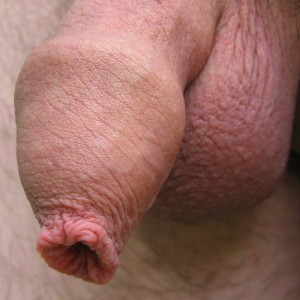
An acroposthion with its densely packed ‘uni-lip’ nozzle of specialised, pleasure laden specialised nerve receptors
The foreskin’s uni-petal forms one continuous elastic lip, which varies from individual to individual. Foreskins can be stretched to lengthen and widen the overhang, thus encouraging the development of an acroposthion with regular, ongoing practice and perseverance. It’s almost certain that the ancient Greeks practiced elongating their foreskins. Of course not all foreskins will be lengthy, elastic and of a ‘classical Greek’ disposition. Short foreskins will tend to retract as soon as the penis begins to be aroused and it has been known of men who thought that they’d been circumcised because of the shortness of their foreskins. The length of some foreskins however can be incredibly generous, and it would seem that any man, who has inherited a penis with a lengthy foreskin or a ‘mega-prepuce’, possesses more nerve endings, which therefore bestows greater potential for pleasure to these seemingly very lucky men.
The acroposthion seems to represent the coming together of the whole body via the seam of skin (the raphe), which runs from the anus ending at the frenulum which attaches the foreskin to the glans. The acroposthion adorns and decorates the end of the male ‘flower’, with its bud like appearance, adding to the uniqueness of individual variations and variety. Just as the labial lips are the ‘petals’ of the female’s sex ‘flower’, the foreskin is the ‘petal’ of the male’s sex ‘flower’. It can often resemble a puckered teat or a nozzle like spout of wrinkled or frilled skin. The acroposthion is the protective hood of the human male’s penis and it’s this plumage which provides individuals with their unique adornment and appearance.
FUNCTION
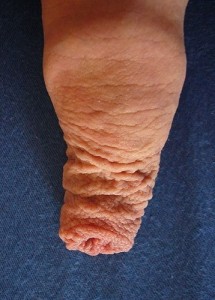
An acroposthion with generous folds of senory laden nerve endings which can produce pleasurably ecstatic sensations when manually or orally stimulated
The Royal Dutch Medical Association (2010) states that many sexologists view the foreskin as “a complex, erotogenic structure that plays an important role ‘in the mechanical function of the penis during sexual acts, such as penetrative intercourse and masturbation’.”
Canadian pathologist and medical researcher Dr John Taylor carried out detailed and definitive research into the foreskin’s anatomy and what its functions might be. While the dense collection of nerve endings in female genitalia (the so-called “g-spot”) had been a focus of research and discussion for some decades previously, it wasn’t until the mid-1990s that Dr Taylor published his first study in what he has called the ‘Ridged Band’, which is the ring of corrugated or ridged skin which is situated at the tip of the foreskin. When the foreskin is retracted it is the acroposthion or the tip of the foreskin that becomes the ridged band. Initially, Dr Taylor was interested in studying the foreskin in order to help him make an informed decision about circumcising his own children (Here’s a link to his website dedicated to the Ridged Band). What he found was that the foreskin is actually a highly specialized tissue that is comparable to an eyelid (foreskins are actually used in eyelid replacement surgery). Dr Taylor says that cutting off the foreskin by circumcision, removes “half of the skin of the penis,” and large amounts of specialized mucosa, which contains specialized nerve endings otherwise known as genital nerve endings, which have been previously mentioned. In simple language, according to Dr Taylor’s research, it is a man’s foreskin that is comparable to the clitoris, not the glans or head as is widely believed. According to Martin Novoa, (Bioethics Advisor at Doctors Opposing Circumcision) “The foreskin is not the candy wrapper – it’s the candy”. Therefore the foreskin and more specifically the acroposthion is potentially the human male’s powerhouse of pleasurably blissful and ecstatic sensations.

Stretching and pulling the foreskin forward as well as widening it by inserting several fingers helps to train it to become longer and more flexible, which can lead to developing an acroposthion
The foreskin’s double-layered sheath enables a gliding action which is the hallmark mechanical feature of the intact penis as it slips in and out of itself enabling the penile skin to glide back and forth over the penile shaft. It can normally be slipped all the way back to the base of the penis and can also be stretched forward beyond the glans, depending on how much foreskin there is. This wide range of motion is the mechanism by which the penis and the orgasmic triggers in the foreskin, frenulum, and glans are stimulated. The double-layered design of the foreskin permits smooth penetration and a sliding action. The skin of the penis, including the foreskin, becomes rougher during erection. This roughness is brought about by a mechanism similar to that which raises goosebumps. The extra frictional resistance brought about in this way reduces slippage of penile skin against female tissues. The double-layering of the foreskin is designed to offset the frictional effect of “erect” penile skin and allow for easy oral, vaginal or anal penetration.
Other functions of the foreskin include the protection of the glans and inner foreskin from chaffing, keratinisation and dehydration, as well as maintaining lubrication through the release of secretions which maintain moisture of the glans and inner foreskin. During sexual activity the foreskin also assists with lubrication when sexual fluids are released. It acts to trap these secretions to maintain the ongoing lubrication of the penis making masturbation and penetration joyful and pleasant experiences.
The foreskin may also possess other capabilities and functions which haven’t as yet been identified, recognized or understood. Scientists in Europe recently detected Oestrogen receptors in its basal epidermal cells. What other, as yet unknown properties and functions does the foreskin hold within its folds? More investigative and definitive research is needed to comprehensively understand this evolutionary wonder of nature bestowed upon human males.
PHIMOSIS
When a foreskin is non-retractable, this condition is called Phimosis [Greek: muzzling] and is the natural state for neonates (new-borns) and boys. The synechia, also known as the balano-preputial membrane or the balano-preputial lamina is the membrane that attaches the inner surface of the foreskin to the glans. A Danish study found that 50% of foreskins became retractable (desquamation) before 10 years of age and 99% of foreskins were retractable by the end of puberty through the vigorous erections of adolescence, helped by masturbation. Therefore the foreskin should be left alone whilst a boy is growing up and should NOT be forcefully retracted for any reason whatsoever, because it may tear or harm the penis in some way. The only person to retract a child’s foreskin should be the child himself, when he’s discovered that his foreskin is ready to retract. The only exception would be if the boy isn’t able to urinate. It’s important to mention that ballooning of the foreskin during urination is normal and common to many boys and shouldn’t be seen as a problem.
Adult Phimosis, also referred to as ‘preputial stenosis’ [Latin: praeputium = foreskin & Greek: stenosis = narrowing] is a condition whereby the foreskin is unable to be retracted fully over the glans. Preputial stenosis would seem to be an issue for around 4% of adult men and has in the past been traditionally managed medically by circumcision, which is the cutting off altogether of the foreskin. There are ongoing debates as to whether circumcision is the appropriate answer to dealing with adult preputial stenosis, but individuals need to inform themselves to ultimately decide what’s best for them. A phimotic foreskin is preferable to having a circumcision as the nerve endings in the foreskin undoubtedly provide pleasurable sensations when stimulated.
Many men live quite happily and comfortably with a non-retractable foreskin and it might seem that it’s other people who have issues with their non-retracting foreskins. There are several less radical treatments than circumcision to treat tight foreskins. Preputioplasty or prepuce plasty, also known as “limited dorsal slit with transverse closure” is a plastic surgical operation on the foreskin to widen a narrow non-retractile foreskin which cannot comfortably be drawn back off the head of the penis. Another option is to undergo a dorsal slit or superincision, which is a single incision along the upper length of the foreskin from the tip to the corona, exposing the glans without removing any tissue.
Non-surgical treatment for a phimotic foreskin involves stretching with fingers or with the aid of expansion rings in conjunction with the application of a steroidal ointment called Betamethasone (0.5% – 1.0%) three times a day. Here is an excellent guide documenting how it’s possible to make huge improvements with even the most severe phimosis.
Persistence and perseverance is required as this process can take an extended period of time for the foreskin to become retractable, as each individual’s situation will be unique. However, care is required so as not to tear the foreskin through forcible retraction, which will just complicate the situation by prolonging the process and possibly making matters worse. Depending on the tightness, individuals can regularly insert a finger from each hand into the foreskin, stretch sideways and holding it for a period of time to train the foreskin to widen.
Paraphimosis is when the foreskin is retracted, usually during erection and then becomes trapped behind the glans and has difficulty returning forward due to tightness. This condition needs to be resolved rather quickly to prevent tissue damage from lack of oxygen to the glans by squeezing it to force blood out whilst easing and bringing the foreskin forward to re-cover the glans. In extreme circumstances, attendance to the Accident and Emergency department would be required to manage this situation. Training the foreskin regularly by inserting several fingers into it, stretching sideways and holding it for a period of time, eventually loosens the foreskin to prevent it from becoming trapped behind the glans.
Difficulty in retracting the foreskin fully, might not be due to a tight foreskin but rather to a short frenulum, which is also known as frenulum breve. Upon retraction whilst erect the glans penis will bend forward due to the restriction from having a short frenulum. The frenulum can be stretched with Betamethasone or if it can’t be stretched then a frenuloplasty which basically makes a clean cut in the frenulum with no removal of any tissue, is possible.
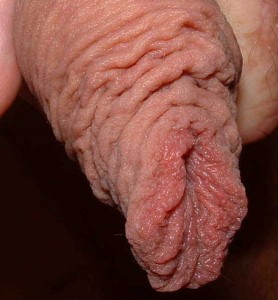
Copious wrinkled acroposthion presents an elegant plumage – The male flower’s ‘petal’…THE powerhouse of ecstatic, pleasurable sensations
Educational medical slideshow covers the development and functions of the prepuce (foreskin) from before birth through adulthood. The terminology used whilst professional is comprehensible to a lay audience
Ken McGrath, Senior Lecturer in Pathology at the Faculty of Health, Auckland University of Technology and Member of the New Zealand Institute of Medical Laboratory Scientists discusses his research into the neural anatomy of the human penis and the physical damages caused by circumcision

